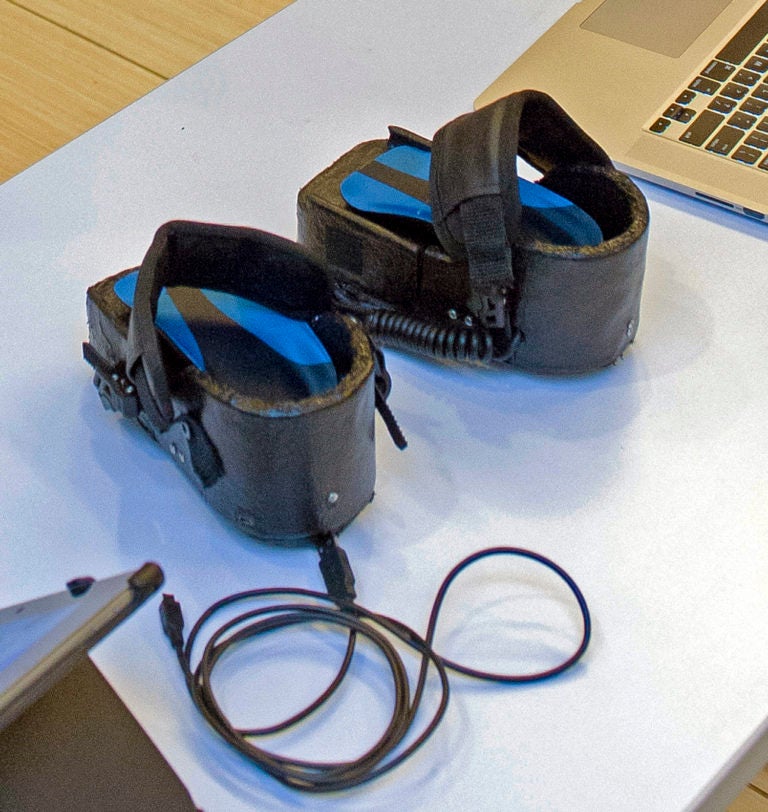New Wearable Will Help Amputees Play Video Games With Their Feet
The makers have already played favorites like Counter-Strike and World of Warcraft

We may earn revenue from the products available on this page and participate in affiliate programs. Learn more ›

Online gaming can be an equalizer, a place where it doesn’t matter what you look like so long as you’re killing the crap out of every other character. Double arm amputee George Levay knows that better than most. He’s the one beating you.
Levay built a pair of video game-controlling sandals alongside partners Nate Tran and Adam Li, and was equally good playing certain video games as any other player. The so-called GEAR (Game Enhancing Augmented Reality) team recently won the $7,500 grand prize for their controller in the 2016 Intel-Cornell Cup for their invention.
Levay lost both his hands, parts of his feet and some of the skin on his face due to complications from a meningitis infection in 2010 when he was an undergraduate studying in his native Hungary. He eventually finished his bachelors degree and received a Fulbright scholarship to study at Johns Hopkins where he linked up with Li and Tran. The idea for the GEAR controller came from a class assignment: build an alternative kind of control device for computers.
“I asked if we could do something I could actually use even though it might not be the most effective way to get an A in the class,” Levay told Popular Science. “[Li and Tran] said of course.”
The team hopes the GEAR controller will benefit non-amputees, too. “We started off wanting to build something George could use, but the end result was something that anyone can use. People with strokes, for example,” Tran told Popular Science.

The sandals consist of three silicone padded pressure sensors that sit beneath the foot, with one sensor at the heel and two at the sole. Pressing down on each sensor or combination sends a signal corresponding to certain buttons or combination of buttons. One foot is currently programmed to control forward, left, right and backwards movement, while the other controls actions like jump, crouch, shoot, or whatever buttons you might need in a game. The system recognizes eight different types of inputs, four per foot, but eventually Levay thinks fifteen inputs is “absolutely doable,” and about as many buttons as would be needed for most games.
Prosthetist Rob Dodson from Advanced Arm Dynamics in Texas hasn’t employed a GEAR controller yet, but said he thought it would be an important tool for his arm amputee patients. He also said he didn’t think there were great existing options for arm amputee gamers. “A lot of our patients are ages 20 to 40 and in the time of their life where gaming is important to them. Even partial-hand amputees look at me and say they used to video game a lot and can’t anymore.”
Meanwhile, Dodson eventually hopes to see a myoelectric, or muscle-sensing controller that attaches to the patient’s limb, which could train patients to control myoelectric prosthetic arms and play games simultaneously. There are relatively inexpensive myoelectric controllers on the market like the $199 Myo, but an armless or handless patient might have trouble with certain controls; the Myo is turned on by tapping the thumb and the forefinger.
The GEAR team has patented their controller and hopes to license the design so another company can manufacture and distribute it. The boots cost around $50 to $75 to produce, but Levay sees a much lower construction cost in the future. He said the team hopes GEAR to be sold for around $100, but cautioned that this was just a loose preliminary estimate.
Combined with a trackball, Levay could play games like Counter-Strike, World of Warcraft or Mirror’s Edge, and kick ass doing so. The team put together the video below of three people with traditional controllers and Levay on the GEAR controller playing Mirror’s Edge, a game where players use parkour techniques to navigate a map. They surveyed 50 or so people to guess which character was controlled by an amputee. Can you tell?

Levay controlled the character on the bottom left, the one who finished the course first.
“[The survey] really proved that when you’re playing a video game and only see the virtual reality, how well a person plays doesn’t transalate into whether that person has a disability; it only translates into whether they’re good at the game or not,” Levay told Popular Science. “I’ve been in the US for a year but people still stare. There’s something that goes along with looking different, but you don’t have to face that in virtual reality. It’s comforting.”